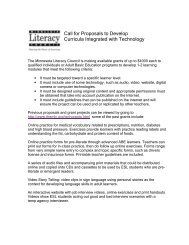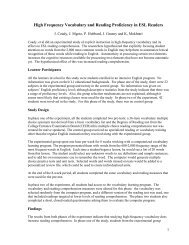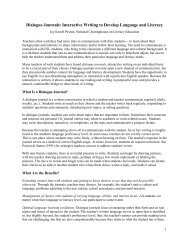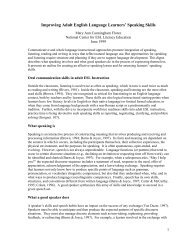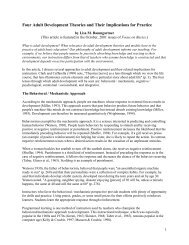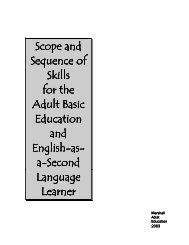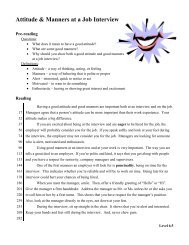Using Multicultural Children's Literature in Adult ESL Classes
Using Multicultural Children's Literature in Adult ESL Classes
Using Multicultural Children's Literature in Adult ESL Classes
You also want an ePaper? Increase the reach of your titles
YUMPU automatically turns print PDFs into web optimized ePapers that Google loves.
th<strong>in</strong>k?” or pose more specific questions to focus the discussion. It is also important to discuss thetheme of structures identified <strong>in</strong> the preread<strong>in</strong>g stage. An oral comprehension check can serve as areview of the story and as an <strong>in</strong>formal assessment.To build the read<strong>in</strong>g-writ<strong>in</strong>g connection, students can record their reflections <strong>in</strong> a journal. They cancopy the title, author, and date at the top of the page and then write briefly about their favorite part,how the story made them feel, someth<strong>in</strong>g they learned from the story, or a similar <strong>in</strong>cident thathappened to them. They can share these reflections orally, as appropriate.Extension ActivitiesLearner-centered literacy activities, from round rob<strong>in</strong> story tell<strong>in</strong>g to rewrit<strong>in</strong>g book end<strong>in</strong>gs, tocompos<strong>in</strong>g stories stimulated by the book, can follow the <strong>in</strong>itial read<strong>in</strong>g (Smallwood, 1991); Toml<strong>in</strong>son& McGraw, 1997).Conclusion<strong>Multicultural</strong> children’s literature can be effectively <strong>in</strong>tegrated <strong>in</strong>to family literacy and adult <strong>ESL</strong>programs to develop English language oral proficiency, literacy, and content skills and to build crossgenerationalcollaboration and appreciation of other cultures.Recommended Books for <strong>Adult</strong> <strong>ESL</strong> <strong>Classes</strong>This book list was developed from the six selection criteria for adult learners described above. AnEnglish proficiency level was identified for each book, based on grammatical structures <strong>in</strong> theCalifornia standards for adult <strong>ESL</strong> programs (California Department of Education, 1992). Theproficiency levels also reflect the amount of text per page, overall complexity of language andvocabulary, and level of the story’s concreteness (vs. abstractness). These levels are meant to guideteachers, not limit them; therefore, teachers are encouraged to try any of these books with any group ofstudents, edit<strong>in</strong>g, simplify<strong>in</strong>g, or amplify<strong>in</strong>g as needed.Beg<strong>in</strong>n<strong>in</strong>g LevelL<strong>in</strong>den, A.M. (1992). One smil<strong>in</strong>g grandma. A Caribbean count<strong>in</strong>g book. Illustrated by L. Russell.New York: Dial. This <strong>in</strong>tergenerational story would suit a family literacy class.Low. W. (1997). Ch<strong>in</strong>atown. New York: Henry Holt. Simple sentences and descriptive illustrationscapture daily life <strong>in</strong> New York’s Ch<strong>in</strong>atown. Celebration of Ch<strong>in</strong>ese New Year is highlighted. Theauthor/artist is from Ch<strong>in</strong>atown.Miranda, A. (1997). To market, to market. Illustrated by J. Stevens. New York: Harcourt Brace. Thisadult spoof on the classic children’s nursery rhyme has a repeated refra<strong>in</strong>, rhym<strong>in</strong>g words, and food andanimal vocabulary.Morris, A. (1992). Houses and homes. Photographs by K. Heyman. New York: Lothrop, Lee &Shepard. Stunn<strong>in</strong>g color photographs and limited text present homes around the world. See alsoBread, bread, bread (1989), by the same author, photographer, and publisher, done with the samemature style and multicultural approach.2
Low-Intermediate LevelCox, J. (1998). Now we can have a wedd<strong>in</strong>g. Illustrated by D. DiSalvo-Ryan. New York: Holiday House. An<strong>in</strong>ter-ethnic wedd<strong>in</strong>g is planned, and friends and fellow tenants <strong>in</strong> their apartment build<strong>in</strong>g prepare food fromaround the world for the celebration.Garland, S. (1993). The lotus seed. Illustrated by T. Kuichi. New York: Harcourt Brace Jovanovich. A s<strong>in</strong>glelotus seed provides cont<strong>in</strong>uity for a Vietnamese family. The granddaughter tells her grandmother’s emotional andtraumatic story <strong>in</strong> one to two sentences per page <strong>in</strong> a semi-poetic format. Some challeng<strong>in</strong>g language andvocabulary is <strong>in</strong>cluded.Garza, C.L. (1996). In my family/En mi familia. San Francisco, CA: Children’s Book Press. These authenticvignettes of family life <strong>in</strong> south Texas, by the author and illustrator, a famous Mexican-American artist, aresimply written, with one topic per page.Sakai. K. (1990). Sachiko means happ<strong>in</strong>ess. Illustrated by T. Arai. Emeryville, CA: Children’s Book Press. Inthis Japanese family, roles change, as the grandmother beg<strong>in</strong>s to lose her memory and her granddaughter learns toaccept her as she now is.Say, A. (1993). Grandfather’s journey. Boston: Houghton Miffl<strong>in</strong>. This story is about the author’s grandfather,who journeyed between his two cultures—Japanese and American. The sparse text has some challeng<strong>in</strong>gvocabulary and syntax.Spenser, E. (1993). A flag for our country. New York: Steck-Vaughn. This simply told story of Betsy Ross andthe mak<strong>in</strong>g of the American flag has some difficult grammatical patterns. It is good for citizenship and Americanhistory classes.High-Intermediate LevelBartone, E. (1996). American too. Illustrated by T. Lew<strong>in</strong>. New York: Lothrop, Lee & Shepard. AnItalian-American adolescent girl bridges two cultures. New York City <strong>in</strong> the early 20 th century comesalive with Lew<strong>in</strong>’s artistry. See also Peppe the lamplighter (1993), by the same author and publisher,about an Italian-American boy who proudly works <strong>in</strong> a menial job to help his family.Bresnick-Perry, R. (1992). Leav<strong>in</strong>g for America. Illustrated by M. Reisberg. San Francisco, CA:Children’s Book Press. Based on a true story, this Russian-Jewish immigration saga highlights thetrauma of leav<strong>in</strong>g home. The <strong>in</strong>ter-generational story has a detailed story l<strong>in</strong>e and some complexsentence patterns.Bunt<strong>in</strong>g, E. (1991). Fly away home. Illustrated by R. Himler. New York: Clarion Books. This storyabout homelessness has some grammatical complexity. See also The wall (1990), by the same author,illustrator, and publisher, about the Vietnam memorial.Kurtz, J., & Kurtz, C. (1997). Only a pigeon. New York: Simon & Schuster. This journey <strong>in</strong>to theurban life of modern Addis Ababa is told through the eyes of an Ethiopian adolescent boy who works,goes to school, and proudly raises pigeons. The prose is enhanced by realistic, soft watercolorpa<strong>in</strong>t<strong>in</strong>gs.Lew<strong>in</strong>, T. (1997). Fair! New York: Lothrop, Lee & Shepard. Lew<strong>in</strong>’s large, colorful and detailedillustrations accompany text about an American cultural experience, the county fair. This book<strong>in</strong>troduces a lot of vocabulary <strong>in</strong> a number of verb tenses.3
Maestro, B. (1996). Com<strong>in</strong>g to America. The story of immigration. Illustrated by S. Ryan. NewYork: Scholastic. This illustrated history of immigration is historically accurate, yet simplified for apicture book format. It provides additional <strong>in</strong>formation at the end of the book (e.g., a table of dates).Orr, K. (1990). My grandpa and the sea. M<strong>in</strong>neapolis, MN: Carolrhoda Books. The wisdom of asimple fisherman is honored <strong>in</strong> this story, set on the Caribbean island of St. Lucia. The<strong>in</strong>tergenerational conflict lends itself to class discussion.Advanced LevelAshabranner, G. (1993). Still a nation of immigrants. Photographs by J. Ashabranner. New York:Cobblehill/Dutton. This 125-page book explores the issues of immigration today. It is divided <strong>in</strong>tochapters and also smaller subsections, so a teacher can easily select a 3-5 page passage for classroomuse. It highlights successful immigrants from a range of cultures. Black and white photographsenhance the text.Nye, N. S. (1996). The same sky. A collection of poems from around the world. New York: Allad<strong>in</strong>.This selection of short, orig<strong>in</strong>al poems was written by children and adults from all over the world. It isorganized <strong>in</strong>to topics (e.g., families, dreams, and dreamers). Marketed as a children’s book, the poetryhas appeal for all ages.ReferencesCalifornia Department of Education (1992). English as a second language model standards for adulteducation programs. Sacramento, CA: AuthorRudman, M. K. (Ed.) (1993). Children’s literature: Resources for the classroom (2 nd ed.) Norwood,MA: Christopher-Gordon.Smallwood, B.A. (1991). <strong>Multicultural</strong> children’s literature: A cross-cultural, thematic curricularapproach for English as a second language learners <strong>in</strong> grades K-6. Unpublished doctoral dissertation.Fairfax, VA: George Mason UniversityToml<strong>in</strong>son, E., & McGraw, R. (1997). Children’s literature <strong>in</strong> adult EFL classes: Learn<strong>in</strong>g throughresponse. The Journal of the Imag<strong>in</strong>ation <strong>in</strong> Language Learner IV, 50-57.Downloaded from http://www.cal.org/ncle/digests/4



